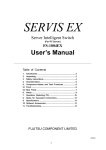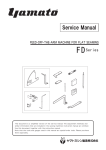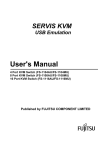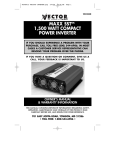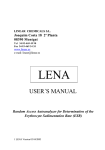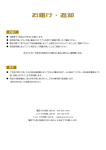Download User Manual
Transcript
SERVIS 8-port KVM Switch Integrated Console Drawer [FD-1008AT] 16-port KVM Switch Integrated Console Drawer [FD-1016AT] User’s Manual 2 FCC WARNING: Changes or modifications not expressly approved by the party responsible for compliance could void the user's authority to operate the equipment. This equipment has been tested and found to comply with the limits for a Class A digital device, pursuant to Part 15 of the FCC Rules. These limits are designed to provide reasonable protection against harmful interference when the equipment is operated in a commercial environment. This equipment generates, uses, and can radiate radio frequency energy and, if not installed and used in accordance with the instruction manual, may cause harmful interference to radio communications. Operation of this equipment in a residential area is likely to cause harmful interference in which case the user will be required to correct the interference at his own expense. All Rights Reserved, Copyright© FUJITSU COMPONENT LIMITED 2005 3 Contents 1. 2. 3. 4. 5. 6. 7. 4 PREFACE ................................................................................................................................. 6 1.1 Conventions.................................................................................................................................... 6 1.2 Packing List .................................................................................................................................... 6 IMPORTANT NOTICES ............................................................................................................ 8 2.1 Safety Information........................................................................................................................... 8 2.2 Disposal........................................................................................................................................ 10 2.3 Moving Console Drawer................................................................................................................ 11 INSTALLATION ...................................................................................................................... 12 3.1 Installing the Guide Rails (when using a tapped guide rail)........................................................... 12 3.2 Installation Procedure ................................................................................................................... 12 3.3 Installing Console Drawer ............................................................................................................. 14 NAMES AND FUNCTIONS OF PARTS.................................................................................. 15 4.1 Overview....................................................................................................................................... 15 4.2 Console switches.......................................................................................................................... 16 4.3 Rear Panel.................................................................................................................................... 17 4.4 DIP Switch Settings ...................................................................................................................... 18 CONNECTING AND REMOVING CABLES ........................................................................... 19 5.1 Connecting Cables ....................................................................................................................... 19 5.2 Removing Cables ......................................................................................................................... 21 OPERATION ........................................................................................................................... 22 6.1 Operating the Console Drawer...................................................................................................... 22 6.2 Monitor Adjustment ....................................................................................................................... 24 6.4 Resolutions and Refresh Rates, and LCD supporting video signal ............................................... 27 6.5 Hot-Key SW Operations................................................................................................................ 28 6.6 Keyboard Operation, LED Indicators and the Reset SW............................................................... 28 6.7 Pointing Device Operation ............................................................................................................ 30 6.8 Switching Servers ......................................................................................................................... 31 6.9 Selecting a Server when the Power is ON .................................................................................... 31 6.10 Selecting the Hot Key Mode ......................................................................................................... 31 6.11 Setting/Changing Server Names................................................................................................... 37 6.12 Constant Server Name Display Function ...................................................................................... 38 6.13 EDID Setting Mode ....................................................................................................................... 39 6.14 Storing Console Drawer................................................................................................................ 40 6.15 Cleaning the Console Drawer ....................................................................................................... 41 TECHNICAL SPECIFICATIONS............................................................................................. 42 8. TROUBLESHOOTING ............................................................................................................ 45 8.1 No Monitor Display ...................................................................................................................... 45 8.2 Inability to Adjust Monitor Display ................................................................................................. 46 8.3 Other Irregularities in Monitor Display ........................................................................................... 46 8.4 Others........................................................................................................................................... 47 5 1. Preface Thank you for your purchase of this rack-mount KVM Switch Integrated Console Drawer. This product will bring you great improvement of efficiency and server switching functionality of your workspace. Space that was used in previous configurations can now be used more freely due to our compact sliding module design. The 15-inch TFT monitor has a resolution of 1024 x 768 dots with 16,770,000 colors. Also, it is equipped with a keyboard and 3-button pointing device. The Console Drawer can be used for the systems that have the support for Analog RGB separate sync video signal and input device interface of PS/2, USB, Sun I/O and USB. The Console Drawer cannot Display over the specification that LCD is supporting. This user’s manual applies to both the 8-port and 16-port KVM Switches. However, unless otherwise mentioned, all descriptions in this manual refer to the 8-port KVM Switch. *KVM Switch: Keyboard Video Mouse Switch 1.1 Conventions Symbols and terminology that are used in this manual are described below. This symbol indicates the possibility of physical damage (to this CAUTION product, or server) or physical injury, which may result through improper operation. This logo indicates supplemental information, comments or hints ● Text that is preceded by a sequence of numbers (1, 2, etc.) means that the operations must be performed in the indicated order. ● References to important chapter titles and terminology are in brackets [ ]. 1.2 Packing List Make sure that the items in the following list were included in the shipping package. ● KVM Switch Integrated Console Drawer ×1 ● Operation manual (this manual) ×1 ● AC Power cable (2m) *1 ×1 *1. For USA only We recommend keeping the box and packing material in which the Console Drawer was purchased, and they may be required when moving it to another location. If you have any problems in our products, contact with your place of purchase or your salesperson. 6 CAUTION Please note the safety information in [Important Notices]. 1. Unpack the Console Drawer and check that it has not been damaged in transit. 2. Remove the rubber stabilizer from the front left side of the Console Drawer. The rubber stabilizer is inserted to prevent the Console Drawer from sliding when installing or moving it. Be sure to keep it after finishing the installation for when it needs to be used again. “Rubber stabilizer removal” 7 2. Important Notices This chapter contains cautions that must be taken when operating the Console Drawer and information related to safety. Carefully read this chapter to use the Console Drawer correctly. 2.1 Safety Information CAUTION Precautions This device conforms to the safety standard related to information processing equipment such as electronic office machines that are used in an office environment. In details of standards, please refer to the technical specifications described in this end of manual. ● To prevent extreme bumping, shaking, vibration while moving the Console Drawer, please use the original shipping container or a similar box, in addition make sure if it fits well to the product for protection. ● During installation and before using the Console Drawer, carefully read [Installation] and the section about environmental conditions in [Technical Specifications] to use the Console Drawer correctly. ● Moving the Console Drawer from a cold environment to the installation location may cause condensation to occur. Before using the Console Drawer, allow it to dry out completely and to reach the ambient temperature of the installation location. ● Make sure that the local power supply voltage is within the acceptable range of the Console Drawer. Make sure that the rated voltage meets the specifications of this device (Refer to [Technical Specifications] and the model plate on this device). ● The Console Drawer's power cable is specially certified. Do not connect it to anything other than a rack power outlet in order to avoid electric shocks and/or short circuits. ● Arrange the adequate area to have the plug quickly pulled out around the Console Drawer's power socket or the rack's power outlet. ● Lay all the cables so that they will not be damaged. Refer to the relevant sections in [Installation] when connecting and removing cables. ● Do not connect or remove the data transmission cables during thunderstorms. ● Do not allow foreign substances (such as necklaces or paperclips) or liquids inside the Console Drawer. ● In an emergency (such as: damage to the housing, parts or cables; or liquid or a foreign object has fallen into the Console Drawer) remove the power cable as soon as possible and contact your place of purchase or our authorized maintenance person. ● Do not disassemble or modify the Console Drawer for any purpose, which may cause electric shocks, or fire and so on. Only licensed engineers may repair the Console Drawer. ● Do not pull up cable with a jerk. Be sure to hold connector when pulling up cable. ● Avoid using the keyboard when in poor health or for extended periods of time. ● Avoid operating the Console Drawer with wet hands. 8 ● ● ● ● ● ● ● ● ● ● ● ● ● Do not plug or unplug connectors with wet hands. Do not place unnecessary items, such as cups, on the top of the Console Drawer. Do not modify or repair the Console Drawer. Only authorized personnel may disassemble, remove or switch parts (such as power supply units) that bear a warning mark (such as a lightning bolt mark). Only the resolutions and refresh rates specified in [Adjusting the Monitor] can be set. Doing settings other than those noted may damage the monitor. To prevent interference, it is necessary to adequately isolate the data cables connected to peripheral equipment. To cut off the power supply, unplug the power cable from the rack power outlet Follow the instructions in the appropriate section in [Operation] when cleaning server. Keep this manual beside your Console Drawer at all times. Do not use the Console Drawer as a stepladder or lean against it with it drawn out. Doing so may unbalance the rack, causing it to fall over. When the Console Drawer is drawn out, be careful not to bump into it, which may cause injury. It is recommended to retract the Console Drawer into the rack when not using it, or when handling other devices in the rack such as servers or peripherals. Some limited life components (such as the LCD, etc.) are included in this product. In cases of extended continuous use, the performance of these components is easily decreased. To cut the power supply, unplug the power plug from the grounded power outlet. CAUTION Safety Instructions Read the "Safety Instructions" before use to ensure proper use of this product. Safety Instructions contained in this section are written for the user to avoid any damage to property or self-injury. Please read the following carefully: ● Verify that the power to the server is off before handling any connectors. Also, be sure to discharge any static electricity. Connecting or disconnecting the connectors while carrying a static charge or while the power to the server are on may damage the server or this device. Note that damage of this kind is not covered by the warranty. ● Connecting with server requires special optional cables (1.8m, 3m and 5m cables for PS/2, USB, Sun I/O and USB interface). The maximum cable length is 5m. Use a 1.8m cable for cascaded connections. Please note that cables longer than specified are not covered by the warranty. ● Only PC (machine) and Sun server can be hooked up to this device, and each server must be equipped with the following type of keyboard, mouse and monitor connectors with the unique optional cables. Other types are not supported. Additionally, the analog RGB composite video signal is not support in the monitor part. The Console Drawer cannot Display over the specification that LCD is supporting. ● Use of standard equipment is recommended because special keyboards (programmable, wireless) and mice (wireless or that require a special driver) may not be supported/operate. 9 ● The keyboard connector for this switch device is a PS/2 type (Mini DIN 6P female), but you can connect an AT-type (DIN 5P male) keyboard by using a PS/2 ↔ AT adapter. A USB type keyboard may not be used as the console keyboard. ● The mouse connector for the switch device is exclusively for PS/2 connection (Mini DIN 6P female). A serial or USB-type mouse may not be used as the console mouse. ● When using a mouse with a scroll function of a mouse with PS/2 wheel, There is a possibility it does not work properly in the case the scrolling is beyond spec(support) Also, depending on the software used, the scroll function may not work correctly. ● The keyboard and mouse connectors are the same shape. Be sure the colors match to connect them correctly. If they are forced in or connected incorrectly, the connected devices may not function, or may cause device failure. ● Set up the console’s keyboard and mouse with each server correctly. If they are not set correctly they will not operate normally. ● Hook up the cables for each port to the same server. If the monitor, keyboard, and mouse port numbers are wrong, you will not be able to select the server correctly. ● A DVI (Digital Video Interface) compatible display can not be connected. ● When connecting a monitor other than the one for Console Drawer, use one that is multi-scan compatible, and set the correct resolution. KVM Switch supports resolution 1600 ×1200, refresh rate 75Hz. Also, the display may be shifted off center after switching, which depends on the monitor and resolution settings. Setting with monitor or video card is required when this happens.*This device’s LCD can display up to 1024*768 dots (75Hz). When using external monitor, up to 1600*1200 dots display (75Hz) is possible. ● Degradations in high resolution screen quality, such as ghosts or blurring, may be due to the monitor cable or video card. Also, the screen may not display normally sometimes, depending on the particular combination of display and video card. Try changing the settings of the environment in which the video card, for example, is connected. ● The monitor cable connector is a Mini D-SUB 15P type. Make sure you connect it in the correct orientation and use the fixing screws to hold it in place. It may cause trouble if it is not connected properly. ● Cascaded connections must be setup exclusively with our KVM switches only. You can not make these connections with switches produced by other manufacturers. ● A maximum of two levels of cascaded connections are allowed (including the master). Attempting to cascade three or more levels will not work. 2.2 Disposal CAUTION 10 This device consists of metal, plastic, electronic parts and so on. Some electronic components, such as LCD monitor, include lead. When it is disposed of, follow exactly the relevant government regulations, instructions and so on. 2.3 Moving Console Drawer CAUTION 2.4 When moving the Console Drawer to a different location, use the box in which it was purchased or a box that protects the product from bumping and shaking. Do not unpack the Console Drawer until the move has been completed. Safety Precautions and Limited Warranty Information: Fujitsu’s Products are not designed for use in medical or life support appliances, devices, or systems where malfunction of a Product can reasonably be expected to result in a personal injury. The Product is designed, developed and manufactured as contemplated for general use, including, general office use, personal use, household use, and ordinary industrial use, but is not for use for high risks or dangers that could reasonably be expected to result in personal injury, or other loss including without limitation, nuclear application, aircraft flight control, air traffic control, mass transport control, medical life support system, or missile launch control in weapon system (“High Safety Required Use”). You should not use this Product without securing sufficient safety required for such High Safety Required Use. Purchaser and its customers using or selling Products for use in such applications do so at their own risk and agree to fully indemnify Fujitsu for any damages resulting in such improper use or sale. Fujitsu Component Limited or its affiliates (“Fujitsu”) warrants all Product against defects in materials and workmanship for a limited period not to exceed one (1) year from the date of delivery to Fujitsu authorized distributor or authorized system integrator (“Authorized Company”). Check with Fujitsu for such Authorized Company. Fujitsu’s liability under this warranty is limited, at Fujitsu’s sole discretion, to repairing, or replacing any component with new or like new components or parts, or replacing with a refurbished or alternative product, or issuing credit for the purchase price, if paid, for such Product that was defective at the time delivered to Purchaser, provided that Fujitsu will not be liable under this warranty unless: (i) Fujitsu is promptly notified in writing upon the discovery of defects by Purchaser; (ii) the defective unit is returned to Authorized Company, transportation charges prepaid by Purchaser; (iii) the defective unit is received for adjustment no later than one year following the date on which such Products were delivered by Fujitsu to Authorized Company; and (iv) Fujitsu’s examination of such units shall disclose, to its satisfaction, that such defects have not been caused by misuse, neglect, improper installation, repair, alteration, accident, improper storage or other action or inaction beyond reasonable practice for such Product. This warranty shall be administered and returned to the party from whom Purchaser purchased Product which is an Authorized Company. 11 THE WARRANTY SET FORTH IN THIS SECTION IS IN LIEU OF, AND EXCLUDES, AND EACH PARTY HEREBY WAIVES, ANY OTHER REPRESENTATIONS, GUARANTEES AND WARRANTIES, EXPRESS, IMPLIED OR STATUTORY, INCLUDING, WITHOUT LIMITATION, ANY WARRANTY OF MERCHANTABILITY, OR FITNESS FOR A PARTICULAR PURPOSE. IN NO EVENT SHALL FUJITSU BE LIABLE TO PURCHASER FOR LOSS OF PROFITS, LOSS OF USE, COST OF SUBSTITUTE GOODS, OR CONSEQUENTIAL OR INCIDENTAL DAMAGES OF ANY KIND BASED UPON A CLAIM FOR BREACH OF WARRANTY OR OTHERWISE. FUJITSU'S WARRANTIES SHALL NOT BE ENLARGED, DIMINISHED, OR AFFECTED BY, AND NO OBLIGATION OR LIABILITY SHALL ARISE OR GROW OUT OF, SELLER'S RENDERING OF TECHNICAL ADVICE OR SERVICE IN CONNECTION WITH BUYER'S ORDER OR THE PRODUCTS FURNISHED HEREUNDER. 3. Installation CAUTION 3.1 Please note the safety information in [Important Notices]. Observe the specified environmental conditions when using the Console Drawer (See [Technical Specifications] for more information). Avoid dust, humidity and extreme temperatures. Installation requires at least 2 two people. Be careful not to pinch your fingers or hands between the guide rails and the Console Drawer. Installing the Guide Rails (when using a tapped guide rail) * These guide rails are optional. Install the guide rails with the guides toward the front so that the Console Drawer can be mounted on them. When using tapped guide rails, install them on the inside of the rack supports. A screw holder may be required depending on the guide rail specifications. See the "Installing the Guide Rails" drawing in following page. 3.2 Installation Procedure 1. Insert the rear spacer studs of the guide rails into the holes in the rear rack pillars. Fasten each guide rail with two screws inserted from the outside of the pillar, one into each of the top and bottom holes of the rear spacer. 2. Extend the guide rails to reach the inside of the front rack pillar. Fasten each guide rail in place with two screws, one into each of the top and bottom holes of the front spacer. (Attach the guide rails inside the front/rear rack pillar so that the guides face inwards.) 3. Install the left and right guide rails at the same height. 12 Rear Spacer Screws Guide Rail Front Spacer Rear Spacer Studs Guide Rear Spacer Screws Guide Rail Front Spacer Front Spacer Rear Rack Pillar Front Rack Pillar “Installing The Guide Rails” 13 3.3 Installing Console Drawer CAUTION Be careful that the latch lever (see detailed mechanism shown in section #6-1-2) does not come loose. If the latch lever comes loose the Console Drawer may slip. This Console Drawer to be held with two people at least. Do not connect the power cable at this point. 1. After installing the guide rails, slide the Console Drawer into the front end of the guide rails. 2. Push the Console Drawer in until it stops, then fasten each screw-hole of the front of Console Drawer by 2 screws. Guide Rail Console Drawer Guides Guide Rail Latch Lever Screw "Installing the Console Drawer" 14 Screw 4. Names and Functions of Parts 4.1 Overview Slide Rail Handle Monitor Power Button Monitor (LCD) LCD Lock Reset Button Hot-key Button Keyboard Guide Rail Slide Rail Pointing Device LCD Lock Latch Lever 15 4.2 Console switches There are one LED and five Buttons at the upper right area of Monitor surface. ―― Power Indicator (LED) ―― Monitor Power Button ―― MENU/ENTER Button ―― + Button ―― - Button ―― AUTO/EXIT Button Power Indicator: It glows green while the power of the monitor is turned on, and glows orange while the monitor is in energy-saving mode. It is off when the backlight power is off. Monitor Power Button: Press this button to turn on the monitor power. When pressing this button while power is turned on, the monitor is turned off. MENU/ENTER Button: Press this button to indicate menu, select or enter the value and so on. + Button: Press this to choose right-side item or increase value. - Button: Press this to choose left-side item or decrease value. AUTO/EXIT Button: Hot-key: 16 Press this to close the menu, cancel the adjustment items or settings, or set to automatic setting. Push this button to display the OSD for switching servers. 4.3 Rear Panel 8-Port KVM Switch (1) (2) (3) (4) (5) (6) 8-port KVM Switch Rear Panel (1) Power cable connector Connect power cable to power socket. (2) Connectors for servers [1 through 8 or 16] Connect each port (1 through 8 or 16) on this device to the relevant host’s keyboard, mouse and monitor connectors with the special cable. (3) DIP switches Use for a variety of settings. Numbered from left side while facing the switches starting from 1, 2…8 or 16; up is on and down is off. (4) Keyboard connector Connect a PS/2 keyboard connector (purple). (5) Mouse connector Connect a PS/2 mouse connector (green). (6) Monitor connector Connect a monitor. 16-Port KVM Switch 16-port KVM Switch Rear Panel 17 4.4 DIP Switch Settings The factory default settings are as follows: 1 2 3 4 5 6 7 8 ON OFF (*Note: the DIP Switch Functions SW No. Function 1 Hot Key Mode: <Ctrl>+<Alt>+<Shift> and Hot-Key SW 2 Hot Key Mode: Double <Ctrl> 3 Hot Key Mode: Double <Scroll Lock> 4 Country Setting bit 1 5 Country Setting bit 2 6 Country Setting bit 3 7 Country Setting bit 4 8 Power Mode Setting indicates the switch position) ON state / OFF state ON: enabled / OFF: disabled ON: enabled / OFF: disabled ON: enabled / OFF: disabled (see following table) (see following table) (see following table) (see following table) ON: the switch device is always ON. OFF: the switch device turns ON if any connected host is turned ON. The country code (language) settings are as follows: For Sun Microsystems platform only JPN SW4 ON SW5 ON SW6 ON SW7 ON USA ON ON ON OFF GBR ON ON OFF ON GER ON ON OFF OFF FRA ON OFF ON ON ESP SWE ON ON OFF OFF ON OFF OFF ON POR ON OFF OFF OFF TPE OFF ON ON ON KOR ITA OFF OFF ON ON ON OFF OFF ON UNIX OFF ON OFF OFF NOR BEL OFF OFF OFF OFF ON ON ON OFF DEN OFF OFF OFF ON Country Setting 18 5. Connecting and Removing Cables CAUTION 5.1 Read the Console Drawer manual before connecting the cables. Do not connect or remove the cables during a thunderstorm. When unplugging cables hold them by the plug, not the cable. Connect and remove cables in the following order. Connecting Cables Following explanation is based on 8 port KVM built-in drawer and separate purchase of our 8 port KVM. In case of 16 port KVM built-in drawer usage and different combination of 4, 8, 16 port KVM purchase, will be treated by reference of this example connections. 1. Getting started Then confirm that the power cable for each server is plugged into an electric outlet and that the power is off (Confirm connection (1)). 2. Connect the servers 2.1 When using one level KVM Switch (using only one switch device) It is possible to hook up a maximum of 8 servers. 1. Connect the first server’s keyboard, mouse connector and CRT connector with the unique optional cable (connect (2)), next connect the switching device’s Mini D-Sub 15 pin (female) to the special connector (black) (connect (3)). Use the fixing screws to hold the Mini D-SUB15Pin in place. 2. Connect hosts 2 through 8 in the same manner. 3. Connect the console 3.1 Connect the monitor cable and keyboard/mouse cable to the keyboard and mouse connectors (connect (4)). 4. Connect the power cable 4.1 Connect the power cable to the Console Drawer. Next, connect the power cable to an earthed power supply outlet. When connecting the connector (Mini D-SUB 15Pin) for the monitor, use the fixing screws to securely connect the connector to the Console Drawer and server. Otherwise, images may be distorted. 19 5. In the case of a cascaded connection (when KVM Switch is connected in a two-level connection) Enable to connect max 64pcs of servers by cascade connection of Console Drawer when using 1pcs of 8 port KVM switch. 1. Connect the master switch device's ports one through eight to the second level of switch devices (called slaves), in the same way as for the [first level]. 2. Next, use the unique optional cables to attach the [keyboard/mouse] and [DISP] connector of the first level switching device (called master) to the [Keyboard], [Mouse], and [Console] connector on the console ports of the second level slave switch devices. Cascading between 1st level of KVM built-in drawer and 2nd level of KVM shall be connected by 1.8 m PC type of unique optional cable. Note: Please do not use the Sun I/O CN port in console ports area inside the KVM side (2nd level) at the time. 3. To increase the number of slaves, connect them in the same way as described in steps 1 and 2 above. Do not connect slaves beyond the second level. Third level connection does not work. 20 When the Console Drawer is used in a cascaded connection, the connector for the slave Console and for the master-side server can be connected using only the 1.8 m PS/2 unique optional cable. Operation by a cable other than the unique optional cable for the PS/2 cable will not be possible. Note: Do not connect the cables to the connectors marked with an X. 5.2 Removing Cables Unplug the power cords, from the power outlets, of all the equipment that are affected, then remove each cable. 21 6. Operation CAUTION 6.1 Pull the Console Drawer out slowly until the slide rails lock. If they do not lock, the weight of the Console Drawer may cause it to move. Be careful not to pinch your hand when pulling or pushing the slide module, and opening and closing the LCD. Operating the Console Drawer 1. If the rubber stabilizer has not been removed yet, remove it now. 2. Push down on the latch lever on the front left side of the Console Drawer. Pull out the Console Drawer until it clicks. Before pulling out the Console Drawer, make sure that the two screws on the front of it are tightly fixed to the rack. "Pulling out the Slide Module" Diagram 3. Push and raise the LCD lock on the left side of the handle, and then grasp the handle and open the top of the monitor. 4. Turn on the power by pushing the POWER button. 5. Turn on the power of each of the connected servers. 22 Open the monitor completely. Slide Rail Handle Monitor Power Button Monitor (LCD) LCD Lock Reset Button Hot-key Button Keyboard Guide Rail Slide Rail Pointing Device LCD Lock Latch Lever "Opening the LCD" 23 6.2 Monitor Adjustment There are one LED and five Buttons at the upper right area of Monitor surface. ―― Power Indicator (LED) ―― Monitor Power Button ―― MENU/ENTER Button ―― ―― + Button - Button ―― AUTO/EXIT Button Power Indicator: It glows green while the power of the monitor is turned on, and glows orange while the monitor is in energy-saving mode. It is off when the backlight power is off. Monitor Power Button: Press this button to turn on the monitor power. When pressing this button while power is turned on, the monitor is turned off. MENU/ENTER Button: Press this button to indicate menu, select or enter the value and so on. + Button: Press this to choose right-side item or increase value. - Button: Press this to choose left-side item or decrease value. AUTO/EXIT Button: Press this to close the menu, cancel the adjustment items or settings, or set to automatic setting. It is possible to directly adjust screen brightness by pressing the + button or - button when the menu is not displayed. It is possible to perform automatic adjustment (position and focus) by pressing the AUTO/EXIT button when the menu is not displayed. 24 6.3 Basic Adjustment Procedure The basic adjustment procedure is as follows: Some main menu items do not have associated sub-menus, in which case the adjustment screen appears when the item is selected. If the AUTO/EXIT button is pressed at this phase, the screen returns to the main menu without saving the setting values and any adjustment made to settings will not be saved. The only exception is adjustment of the brightness; any adjustment is always stored by depressing +buttons directly, without entering the menu. 25 Main Menu Items Symbol Descriptions BRIGHTNESS Features It adjusts the screen brightness. CONTRAST It adjusts the screen contrast. COLOR It adjusts the screen color. Fixed values or individual color tones (red, green, blue) can be set. POSITION It adjusts the display position (horizontal and vertical). CLOCK It adjusts vertical striping (noise). FOCUS It adjusts horizontal noise and sharpens up blurred on-screen lettering. sRGB It sets the sRGB functions on/off. BLACK LEVEL It adjusts black color offset level. GRADATION It adjusts the gradation of the color. TEXT MODE It sets the DOS screen resolution. Be sure to set 720 x 400 when using DOS. INFORMATION It shows the current major setting value, such as the screen resolution, vertical frequency, etc. (not all settings are shown) RECALL Restore factory default values. ● SETTINGS Reset to factory default values. ● GEOMETRY Reset the default value for the screen resolution, POSITION, CLOCK, and FOCUS. ● COLOR Reset the default value for the BRIGHTNESS, CONTRAST, BLACK LEVEL, and COLOR . 26 6.4 Resolutions and Refresh Rates, and LCD supporting video signal Resolution and refresh rate: Resolution Horizontal frequency (kHz) 31.5 640 x 400 640 x 480 720 x 400 800 x 600 1024 x 768 31.5 37.5 37.9 31.5 35.2 37.9 46.9 48.1 48.4 56.5 60.0 Vertical frequency (Hz) 70 60 75 72 70 56 60 75 72 60 70 75 Mode VGA 400 LINE VGA Standard VESA Video Signal Supported by LCD monitor part: The monitor supports the analog RGB separate sync video signal. The monitor does not display in case of connection of the different video signal usage. Caution: LCD display Following cases are not considered as a failure mode, and the device can be used normally: - During or soon after power-on, O/S boot-up, power-off , or O/S shut-down, the display position may shift, blink, or otherwise be disturbed. - Any native resolution can be displayed in 1024 x 768, full screen mode, by scaling function. In this case, letters may be blurred and the thickness of thin lines might be uneven. This is because the full-screen display is made by digital interpolation of the low-res output, not by physical magnification. This is not a display failure, and the device can be used normally. - Although there might be some dots or pixels that are always-off (black) or always-on (red, green or blue), this is a natural characteristic of LCDs and is within specification (it is not a defect), and you can use the device normally. 27 6.5 Hot-Key SW Operations To display the OSD menu for switching the server, press in and release this switch. 6.6 Keyboard Operation, LED Indicators and the Reset SW Num Lock LED: Caps Lock LED: Scroll Lock LED: Reset Button: Num Lock enabled (LED ON)/disabled (LED OFF) Caps Lock enabled (LED ON)/disabled (LED OFF) Scroll Lock enabled (LED ON)/disabled (LED OFF) Normally, this is not used. Use only if the server cannot be selected or keyboard/mouse operations are not possible. Lightly press this switch in using the tip of a fine-tipped metallic object such a pin. Resets keyboard and pointing device. Also resets the KVM switch part built-in drawer. However, it will not effect the reset for any secondary (slave) KVM switches. Num Caps Scroll LOCK LOCK LOCK RESET HOT-KEY HOT-KEY SWITCH RESET SWITCH Full keyboard operation is possible by working with the Fn key. Fig US Keyboard 28 Fig EU layout (ex: UK Keyboard) Fig Japanese Keyboard Example of usage: For function of <Scr Lk> key ,press <Fn>+<Num Lk>/<Scr LK>keys. For function of <Pg Up> key ,press <Fn>+<↑>/<Pg Up> keys. 29 6.7 Pointing Device Operation Lightly touch or tap the touchpad surface to operate the pointing device as below: Moving the pointer: Lightly slide a finger over the touchpad surface in the direction you want the cursor to move. Single click: Lightly tap the touchpad surface once, or press the left button once. Double click: Lightly tap the touchpad surface twice, or press the left button twice. Drag: Lightly tap the operation surface twice and without lifting finger, then lightly drag finger across the surface to the desired location. CAUTION 30 1.The pointing device is designed to be operated with one finger, and may not respond correctly if you try to operate it: 1) while wearing gloves; 2) with a pen, ballpoint pen or pencil etc; 3) with two or more fingers; 4) Operating while something is placed on the operation surface. 2.Normal operation may become impossible if the operation surface gets wet such as when there is high humidity or the Operator’s hands are damp or sweaty. Thoroughly dry or wipe the operation surface before use. 3. Do not operate with pointed metal objects such as pens as it may damage the pointing device. 6.8 Switching Servers A server can be selected from the OSD menu (Hot Key Mode). When a currently selected server is turned OFF, that state will be maintained. In this case, switch the desired server using the Hot Key Mode. Keyboard/mouse operations are enabled only on the server currently connected to the selected port. Operation data is not sent to other servers. Note, however, that commands from servers are processed at all times, even if the server is not selected. For this reason, modes (Key Code mode, LED state, type-setting, Mouse Output Mode, etc.) are reflected when switched. 6.9 Selecting a Server when the Power is ON When the power is turned ON while all servers are OFF, the server that is turned ON first is automatically selected. When servers are turned ON at the same time, Servers are selected and connected in numerical sequence (1, 2, 3 …). 6.10 Selecting the Hot Key Mode There are two Hot Key Modes: A and B. There are four ways of displaying the Hot Key Mode as follows: Hot Key Mode A ● Press and release the Hot-Key switch. ● Hold down the <Ctrl>, <Alt>, <Shift> keys at the same time and release. ● Press Scroll Lock twice (Press the Scroll Lock key quickly in succession) Hot Key Mode B ● Press Ctrl twice (Press the Ctrl key quickly in succession) * Enabled/disabled can be set using the DIP switch settings. When the Hot Key Mode is activated, the OSD (On Screen Display) selection screen is shown on the monitor. The Scroll Lock LED on the keyboard blinks quickly. Other LEDs (Num Lock LED, Caps Lock LED, Compose) go out. Keyboard/mouse entry is not possible in the Hot Key Mode. The following shows the indications at each of the connections. *When there is no image (H/V Sync) signal from the currently connected server (suspended state), the OSD menu can be displayed by the image (H/V Sync) signals from other ports. At this time, the OSD menu flashes at 5-second intervals. When the image signal (H/V Sync) is input to the currently selected port, status returns to normal. *H Sync: Horizontal sync signal *V Sync: Vertical sync signal 31 1. OSD screen for a non-cascaded connection (Hot Key Mode A) (Different from actual server name display) 2. OSD screen for a cascaded connection (Hot Key Mode A) Example: OSD Screen with cascaded channel selected [Screen Details] 1. Numbers 1 to 8 and function keys F1 to F8 (for a cascaded connection) indicate the server connection ports. Any numbers 1 to 8 displayed in green indicates that the currently connected server is turned ON. 2. The mark shows the currently selected server. 3. Purple text shows the hosts currently selectable with the cursor keys. 4. SV1-XXXXXXXXXX shows the name of the server currently connected to port 1. 5. The bottom of the screen shows simple explanations of key operations. 6. Cascaded connections are displayed on the slave in blue. (In the above example, channel 5 is in a cascaded connection.) 7. Depending on whether the selected channel has a cascaded slave device attached to it or not, the OSD master device display section changes as follows: - Non-cascaded channel: 14-character wide master device section / nothing in slave section. (The OSD screen is the same without cascade connection.) - Cascaded channel: 3-character wide master device section / 14-character wide slave section. 32 3. Changing the master/slave display when there is a cascaded connection (Hot Key Mode A) Displays 14-character Displays usual 3/14 Displays 14-character Displays usual 3/14 mastertmode while mode when<shift> mastertmode while mode when<shift> <shift> is held down is released <shift> is held down is released Cascade-connected master channel selected Slave channel selected [Screen Details] 1. If a cascade-connected master channel or any slave channel is selected, while the <Shift> key is pressed the OSD screen switches from "3-character master/14-character slave" mode back to "14-character master/5-character slave" mode. The OSD reverts to usual 3/14 mode when the <Shift> key is released. Hot Key Mode B When the <Ctrl> key is pressed twice to enter Hot Key Mode B, a 1-line OSD menu is displayed at the top left of the screen. [Screen Details] 1. The server name is displayed at the top left of the OSD screen. 2. Before switching, the text background turns red. 3. After switching the text background turns blue, and the Hot Key Mode is exited after the switch is completed. 4. The OSD disappears about 3 seconds later. 33 How to switch the server from the OSD screen Switching in Hot Key Mode A The following OSD screen is displayed if you enter Hot Key Mode A after pressing the Hot-Key SW, after pressing the <Ctrl>+<Alt>+<Shift> keys at the same time, or after pressing the <Scroll Lock> key twice. Example of Hot Key Mode A Display for a Cascaded Connection a. [Switching via Keyboard] 1. Use the <↑><↓> cursor keys to select the channel of the server No. on the left side of the OSD screen. 2. If a cascade-connected channel is selected, the state of the selected slave device is shown on the right side of the OSD. 3. If a cascade-connected channel is selected, pressing the <→> cursor key causes control to switch to the right (slave) side of the OSD, with the currently selected cascaded host shown in purple. Press the <←> cursor key to return control to the left (master) side of the OSD. 4. On the right side of the OSD, use the <↑> & <↓> cursor keys as before to select a channel. 5. Press the <Enter> key to actually effect the console switch to the selected server. The name of the server switched to is shown at the top-left of the screen for about 3 seconds after the switch is effected. If ports 1 to 8 are selected when using a 16-port KVM Switch, ports 9 to 16 can be displayed using the <Page Down> key. Ports 1 to 8 can be shown by using the <Page Up> key. 34 b. [Direct Switching via Keyboard] 8-port KVM Switch 1. Use the number keys <1>~<8>. For a cascaded setup, first use the number keys <1>~<8> to select a master-side channel, then use the function keys <F1>~<F8> to select a slave-side port. 16-port KVM Switch 1. To select master port #1: 2. To select master port #14: press <1> (& wait 1 sec), or press <1> then <Enter> press <1><4> on the keyboard (press <4> within one second of pressing <1>) 3. To select master port #2: press <2> on the keyboard 4. With a cascaded connection, select the port where the first cascaded connection on the master side was made. To select slave port #1: press <F1>, or press <F>+<1> (& wait 1 sec) or <Enter> To select slave port #14: press <F>+<1>+<4> (press <4> within one second after pressing <1>) To select slave port #2: press <F2> or <F>+<2> Screens can be switched directly by these key operations. After the screen is switched, the name of the server that you switched to is displayed at the top left of the screen, the OSD screen display disappears after about three seconds, and the Hot Key Mode is exited. When selecting a port in a cascaded connection, first select the cascaded connection port on the master side. Then, select and switch to the port on the slave side. 35 Switching in Hot Key Mode B The OSD menu is displayed at the top left of the screen when the <Ctrl> key is pressed twice and Hot Key Mode B is entered. (Press the <Ctrl> key quickly in succession.) While the text background is displayed in red, the screen can be switched by pressing the desired server number key. a. [Direct Switching via Keyboard] 8-port KVM Switch 1. Use the number keys <1> to <8>. For a cascaded connection, first use the number keys <1> to <8> to select a master-side port, then use the function keys <F1> to <F8> to select a slave-side port. 16-port KVM Switch 1. To select master port #1: 2. To select master port #14: press <1> on the keyboard (& wait 1 sec) or <1>+<Enter> press <1><4> on the keyboard (press <4> within one second of pressing <1>) 3. To select master port #2: press <2> on the keyboard 4. With a cascaded connection, select the cascade-connected port on the master side. To select slave port #1: press <F1>, or press <F>+<1> (& wait 1 sec) or <Enter> To select slave port #14: press <F>+<1>+<4> (press <4> within one second of pressing <1>) To select slave port #2: press <F2> or <F>+<2> Screens can be switched directly by these key operations. Switching the screen also exits the Hot Key Mode. No keyboard or mouse input is accepted while the text background is red. To change the text background back to blue (exit Hot Key Mode), either press a number key, or press the <Esc> key, or the <Enter> key. If the <0> key is pressed while the text background is red, Auto Scan Mode is entered. Auto Scan Mode may be cancelled as follows: <Enter> key: Console switches to the currently displayed screen. <Esc> key: Console reverts to the server active when Auto Scan Mode was started. [Auto Scan Mode] 1. The screen is automatically switched at fixed cycles by pressing the <0> key on the keyboard in the Hot Key Mode. 2. The switching speed (Auto Scan Interval) may be adjusted by pressing the <↑> cursor key to make it faster (shorter) & the <↓> cursor key to make it slower (longer). Allowed Auto Scan Intervals are: 3, 5, 10 (default), 20, 40 and 60 seconds. The new Auto Scan Interval is shown on the OSD for 3 seconds. 3. Servers that are powered OFF are skipped. No keyboard or mouse input is accepted while the Auto Scan Mode is running. 4. To return to Hot Key Mode, the Auto Scan Mode must first be exited. 5. Auto Scan Mode may be exited as follows: <Enter> key: Console switches to the currently displayed screen <Esc> key: Console reverts to the server active when Auto Scan Mode was started 36 6.11 Setting/Changing Server Names Changing a master-side name (Single KVM setup has no blue area) Changing a slave-side name [Screen Details] 1. Select the server name to be set/changed using the cursor keys, exactly as if switching. 2. Press the <Tab> key. The selected name turns yellow, with a single black on yellow character. 3. Use the keyboard to enter the desired name, then press the <Enter> key to confirm it. Use the <Del> key to delete a single character, and the <BS> key to backspace. Use the <Esc> key to cancel name change (revert to original name). 4. A server name may be up to 14-characters long. The following characters (47 to choose from) can be used: ABCDEFGHIJKLMNOPQRSTUVWXYZ1234567890,./[]:+*-+ and <Space> 37 6.12 Constant Server Name Display Function During usual server operation, holding the <Shift> key down and pressing the <Scroll Lock> key twice allows the server name for the currently selected channel to be shown at the top-left of the screen. If the server name is being displayed, holding the <Shift> key down and pressing the <Scroll Lock> key twice causes the server name to disappear from the screen. Server name is not indicated when shipping out. (Initial setting) Server names are not displayed while in the Hot Key Mode or the Auto Scan Mode. While in the Hot Key Mode, holding the <Shift> key down and pressing the <Scroll Lock> key twice will not cause the host name to be shown/hidden. The current Show/Hide Server Name state is retained after switching the server via selector buttons or OSD. If an FS-10x series device (previous model) is used in a cascaded setup, some or all of the server names may not be displayed, depending on the exact setup used. - If a device that is not capable of showing server names is used as the master device, no server names will be shown. - If a device that is not capable of showing server names is used as a slave device, no server names will be shown for the channels of that device. 38 6.13 EDID Setting Mode After pressing the Hot-Key SW, the <Ctrl>+<Alt>+<Shift> keys, or double pressing the <Scroll Lock> to enter Hot Key Mode A, pressing the <N> key causes the display to switch to the Customer Mode: The top line accesses the EDID Setting Mode. The bottom line displays the firmware version currently installed. Pressing the <Enter> key on this screen causes the text background to turn purple, while the EDID information is retrieved from the monitor connected to the console port and written to the internal ROM. After the ROM has been written, the message "PNP MONITOR" is displayed. When EDID information cannot be retrieved from the connected monitor, the message "DEFAULT MONITOR" is displayed, and "00" is written to the ROM. If a new monitor is connected, and the EDID Setting performed, the internal ROM setting is subsequently transmitted to each host automatically. 39 The EDID Setting Mode may be ended as follows: Press the <P> key to return to the Server Selection screen. Press the <Esc> key to escape the Hot Key Mode and return to the usual console screen. EDID for 15" LCDs (Console Drawer) is set before the Console Drawer is shipped from the factory. When Console Drawer is used in a non-cascaded connection, EDID setting is not required. Set EDID when other monitors are connected to Console Drawer, or when a cascaded connection is made. 6.14 Storing Console Drawer The Console Drawer should be stowed away in the rack when the monitor and keyboard are not in use. Slide the Console Drawer in and out of the rack slowly and with care. 1. Push the monitor power button to turn off the power to the monitor. 2. Hold the handle and slowly close the monitor. Be sure that the LCD lock engages. 3. Push the locking springs on both sides of the slide rail and slide the Console Drawer into the rack. Be sure the latch lever engages. CAUTION Be careful not to pinch your fingers in the guide rails, slide rails, or the Console Drawer itself when stowing the Console Drawer. If the latch lever does not lock, the Console Drawer can unexpectly slide out. We recommend turning off the monitor's power when it is not in use, to conserve electricity. Power is still supplied to the keyboard and mouse even if power to Console Drawer is turned off, so there are no problems with server operation. 40 Guide Rail Slide Rail Console Drawer Gable Duct Guide Rail Slide Rail Handle LCD Look Latch Lever Lock Spring "Stowing the Console Drawer” 6.15 Cleaning the Console Drawer CAUTION Turn off the power and unplug the power cable from the power socket. Do not use cleansers that contain abrasives; or such organic solvents as benzene or thinner glue; or disinfectant alcohol. Do not apply water, detergent, or spray-type cleaners directly onto the Console Drawer. If liquids enter the interior of the Console Drawer it can cause malfunctions or damage Wipe the Console Drawer and monitor with a clean dry soft cloth. If the dirt is excessive, wipe it off with a damp-dry soft cloth that has been (thoroughly wrung out after dipping in water). Remove dust with a soft-bristle brush. Clean the keyboard and pointing device with a damp-dry cloth. 41 7. Technical Specifications Item Specification Product ID (KVM Switch Integrated Console Drawer) FD-1008AT/U FD-1016AT/U Number of Connected Servers Max. 8 (more if connections are cascaded) Max. 16 (more if connections are cascaded) Selection Method OSD Display (Hot Key Mode) Hot Key Mode Manual (key operation)/Auto Scan Mode Auto Scan Cycle 3/5/10 (default), 20/40/60 seconds Monitor Plug & Play Function VESA DDC2 compatible LED Display Console Ports KVM Switch Part Monitor Part Keyboard Pointing Device 42 Serv er port Power 1 (Green) Indicator lamp 1 (Orange) Keyboard PS/2 Interface, Mini DIN 6P Female × 1 (Color: Purple) Mouse PS/2 Interface, Mini DIN 6P Female × 1 (Color: Green) Monitor Analog RGB Separate Sync. Mini D-SUB 15P Femalex1 (Color: Blue) Connector Mini D-SUB 15P Female x 8 (Black) Input device I/F Support available I/F with usage of unique optional cables: - PS/2 keyboard and PS/2 mouse I/F - PC USB 1.1 compliant I/F - Sun I/O I/F - Sun USB I/F Monitor Analog RGB Separate Sync. Mini D-SUB 15P Female x 16 (Black) Mini D-SUB 15P Female x 1 Panel monitor 15" TFT color LCD Resolution Max. horizontal 1024 (dots) x vertical 768 (lines) Refresh rate Max.75 Hz Video Signal Analog RGB / Separate Sync. Colors:Max 16,777,216(dithered) Connector mini D-SUB 15-pin, analog RGB, (Color: Blue) Power consumption Max.34W In standby mode: 3.0 W or less When backlight is OFF: 14.0 W or less Layout Us layout/ EU layout/Japanese layout Number of keys 83/84/87 keys Connector mini DIN 6-pin, PS/2, (Color: Purple) Model Static Touch Pad Resolution 220 cpi (counts/inch) Connector Mini DIN 6-Pin, PS/2 (Color: Green) Number of buttons 3 Item Specification Product ID FD-1008AT/U FD-1016AT/U Current supply to keyboard/mouse Max. 300mA Max. 150mA Rate voltage range 100V AC - 240V AC , Frequency 50/60Hz Rated current 0.55A/100V , 0.3A/240V 5 to 35 °C / 10-80%RH(no condensation) Operating Temperature Size (Typ) Main part (W x D x H) (1) Slide rail retracted 485 mm x 642 mm x 42 mm (2) Slide rail extended 485 mm x 1117 mm x 42 mm (3) (2)plus LCD is fully open 485 mm x 1077 mm x 345 mm Construction Painted (Black) Metal Case Weight (Typ) 13kg Standards TUV/GS, FCC A, CE, VCCI A, MIC,C-Tick TUV/GS: EN60950: 2000 FCC part15B CLASS A Canada ICES-003 CE: EN55022:1998 CISPR22:1997 EN55024:1998,A1:2001, A2:2003 EN61000-3-2:2000 EN61000-3-3:1995/ A1:2001 CLASS A VCCI CLASS A MIC CLASS A C-Tick: AS/NZS: 2002, CISPR22:1997, A1:2000 CLASS A CLASS A CLASS A CLASS A 43 Optional Accessories (Sold separately) Item AC cable Interface cables Product ID Remark AC Power cable NC14004-B074 For 8-, 16-port KVM, and all US drawer models* AC Adaptor cable NC14004-B077 PC cable USB cable Sun I/O cable Note: Item Guide Rail 44 For 2-**, 4-port KVM, Cat5 Extender Successor of NC14000-B002. Use this for cascade connection 1.8 m NC14000-B602 3.0 m NC14000-B603 Successor of NC14000-B003 5.0 m NC14000-B605 Successor of NC14000-B005 1.8 m NC14000-B102 3.0 m NC14000-B103 5.0 m NC14000-B105 1.8 m NC14000-B202 3.0 m NC14000-B203 5.0 m NC14000-B205 1. Above P/N for AC cable is US model. 2. AC cable are available for another countries. Contact your Fujitsu Components salespersons. 3. * All US drawer models include AC power cable. ** US 2-port KVM (ATL model) includes AC adapter cable. Product ID Product ID NC14003-T591 M6 tapped rack installation (holes) NC14003-T592 untapped rack installation (oblong holes) Installation from front/rear NC14003-T593 untapped rack installation (oblong holes) Installation from side 8. Troubleshooting 8.1 No Monitor Display Symptom Predicted cause LED light for “Power Indicator” is turned off. The AC cable is not connected to the electric outlet, or to the switch device, or not inserted into the socket properly. Connect the AC cable properly. The AC power is off. Turn on the AC power. POWER button was turned off. Power lamp (green) is out. Turn POWER button ON. No image signal from server. (Suspended state) Input image signal from server. Power Indicator glows The server is in the stand-by mode. orange. Or display shows message of “POWER SAVING” when The monitor cable is not connected, or pressing the not inserted into the socket properly. “MENU/ENTER” button. Although the Power The setting value for resolution and Indicator glows, the refresh rate in server is out of this Monitor does not product capability. display at all, or the Monitor only displays one of the following The AC power for this product was messages. “OUT OF RANGE turned on after the power for the H: ***kHz V: ***kHz, server was turned on SEE USER’S MANUAL,” or “NO SYNC SIGNAL, The monitor cable is not connected, or SEE USER’S not inserted into the socket properly. MANUAL” The video signal from server is not sent as separate sync signal. Solution Press any key in keyboard or operate the touchpad, which makes the server unlock the stand-by mode. Connect the monitor cable properly. Set the proper resolution and refresh rate in the server, which can be supported by this product. Turn on the AC power for this product, before or at the same time when the power for server is turned on. Connect the monitor cable properly This product does not support the composite sync signal, and need to change the server setting for video signal as separate sync signal. 45 8.2 Inability to Adjust Monitor Display Symptom Predicted cause Solution AUTO/EXIT button does not work for automatic setting/adjustment. Instead, following message is displayed in monitor. “AUTO ADJUSTMENT FAILED, SEE USER’S MANUAL”. Following message is displayed. “UNSUPPORTED MODE, SEE USER’S MANUAL” Automatic adjustment was made, when the monitor displayed in the extremely dark mode. Make the automatic adjustment by pressing the AUTO/EXIT button after changing the display as white as possible. The setting value for resolution and refresh rate in server is out of this product capability. Confirm the existing resolution and refresh rate for monitor display through the information of display MENU. Then, set the resolution and refresh rate in the server, which are same value as the confirmation made above. 8.3 Other Irregularities in Monitor Display Symptom Dancing pixel Predicted cause The FOCUS setting is not proper. Resolution Adjust setting in FOCUS. Vertical stripe on monitor. Monitor setting is not proper. Adjust setting in CLOCK, and then adjust setting in FOCUS. Display some noise in black display mode. Video signal from server produces the noise. Window for display shifts, displays over window, displays much small than the window. Display positioning is not adjusted properly. Decrease the value of black color offset level for OSD function in BLACK LEVEL. Adjust display position properly in POSITION, after adjustment value in CLOCK. Set the proper resolution in the server, which can be supported by this product. Confirm and connect the AC cable properly. Adjust setting in CLOCK, then adjust the setting in FOCUS. Monitor turn off occasionally. Uneven thickness of letters, subject to the position displayed in monitor 46 The setting value for resolution in server is out of this product capability. AC cable is not inserted into the socket properly. The setting in FOCUS and CLOCK is not proper. Displayed in lower resolution less than Full-screen display is made by 1024 x 768. digital interpolation of the low-res output, not by physical magnification. So, letters may be blurred and the thickness of thin lines might be uneven by this scaling function. This is not a display failure, and the device can be used normally. Set resolution as 1024 x 768 in “property of monitor” in server, for displaying in best mode. Poor screen quality (Faded images, blurred characters, etc.) Window shifts or does not display when switching 8.4 Connection/cable is defective. Confirm the connector connection. Replace with a different cable. If this solves the problem, replace with a new cable. Adjustment of monitor does not give suitable results. Push Auto switch. Wrong resolution. Adjust the resolution or change the monitor settings. Monitor not supported or out-of-sync when a monitor other than the monitor for Console Drawer is connected. Connect compatible (multi-sync) monitor. Adjust on monitor side. Others Symptom Keyboard and mouse do not operate, or operate strangely. Cause The key repeat is abnormal. Connections to PS/2 ports are disconnected. Connection to PS/2 ports is in reverse with the keyboard and the mouse. A non-specified cable is used. Action Change the speed setting for the key repeat on the server. Check the connection and connect the mouse and keyboard properly. Correctly connect mouse and keyboard. Use a specified cable. A non-supported keyboard or mouse Replace with a supported is connected. keyboard or mouse. Cannot get out of Hot Key Mode. Operation stops after Connection has been disrupted. a period of normal operation. The switcher is hung up. A problem has occurred at the server. Press the [Enter]or[ESC]key. Check the connections and then restart. Press the reset button. Correct the problem at the server. 47 Cannot go into Auto Scan Mode Cannot switch to the Hot Key Mode The auto scan switch cycle is abnormal. Cascaded connections are not recognized. The OSD display flashes at 5-second cycles. 48 Device is not in Hot Key Mode. Set Hot Key. Mode, press the number key (0). Wrong key. Press the number key (0). Wrong key. First level, press the number keys (1 through 8). Second level, press F1 through F8. The switch cycle has not been adjusted. (The default value is 10 seconds) A problem has occurred at the switcher. Use the cursor keys (↑ and ↓) to adjust it. No image (H/V Sync) signal from server (suspended state). Input image (H/V Sync) signal. Or, switch to server having an image (H/V Sync) signal. Press the reset switch. (Both the slave and the master) NOTE NOTE KVM Switch Integrated Console Drawer [FD-10XXAT Series] User’s Manual Published June 2005 Published by FUJITSU COMPONENT LIMITED Printed in Japan All trademarks or registered trademarks are the property of their respective owners. The information contained in this document has been carefully checked and is believed to be reliable. However, FUJITSU COMPONENT LIMITED (FCL) or its affiliates assume no responsibility for inaccuracies. The information contained in this document does not convey any license under the copyrights, patent rights or trademarks claimed and owned by FCL or its affiliates. FCL or its affiliates bear no responsibility for infringement of patent or other rights of third parties attributed to the use of information in this manual. FCL or its affiliates reserve the right to change products or specifications without notice. No part of this publication may be copied or reproduced in any form or by any means, or transferred to any third party without the prior written consent of FCL Please contact your local or regional waste administration to be informed about the collection, reuse and recycling systems. NC14004-L551_01_050823




















































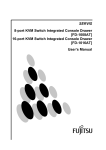
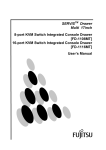
![SERVIS Drawer 17inch [FD-1100AT] User`s Manual](http://vs1.manualzilla.com/store/data/005815433_1-e0ce1fd89f0d0c8bc9b31edbdc395367-150x150.png)
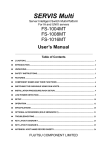


![SERVIS Console Drawer [ FD-1000AT ] User`s Manual](http://vs1.manualzilla.com/store/data/005855835_1-b5ddde4919c279623ac643a1427d1fab-150x150.png)

